April 3, 2015
Air Date: April 3, 2015
FULL SHOW
SEGMENTS

Herbicides Can Boost Antibiotic Resistance
View the page for this story
Herbicides kill weeds, but can spread through the environment, interacting with organisms that include bacteria and humans. A new study published in The American Society for Microbiology suggests that these exposures can affect antibiotic resistance. Host Steve Curwood discusses the research and its implications with UMass Dartmouth’s bacterial geneticist Mark Silby. (06:45)

Growth In Livestock Antibiotics Raises Risks For Humans
View the page for this story
Increasingly bacteria are developing antibiotic resistance, making us vulnerable to all sorts of superbugs. Inappropriate or over prescription for humans is one cause, but Ramanan Laxminarayan, a Princeton University Professor specializing in disease and socio-economics, tells host Steve Curwood that a larger problem could be the overuse of antibiotics in animal agriculture. (07:10)
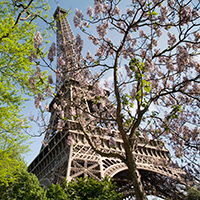
US Advances Climate Plan For Paris Summit
View the page for this story
This fall, officials will gather in Paris to try to thrash out a deal to keep global warming in check. The US has lagged in climate negotiations, but Jennifer Morgan of the World Resources Institute tells host Steve Curwood that now the US is near the front of the pack with its proposal to cut emissions 28% by 2025. (07:10)
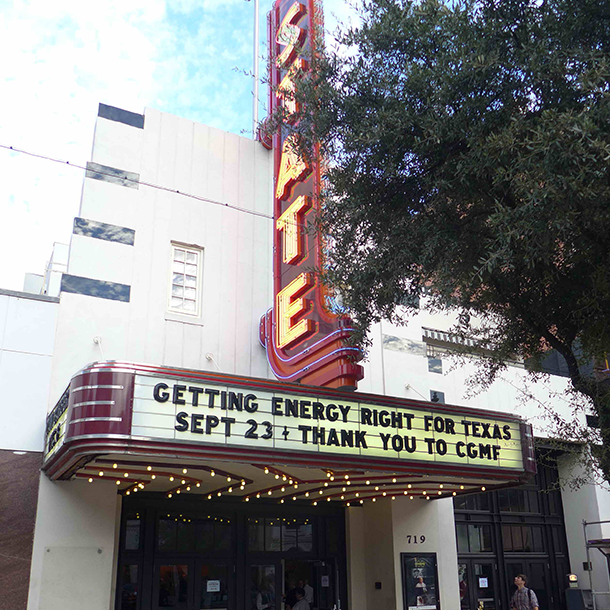
Greening the Tea Party
/ Carl LindemannView the page for this story
There’s increasing environmental awareness among some Tea Party members who see conservation as a conservative value. The Texas Observer’s Carl Lindemann reports that some southern Tea Party members label themselves “green conservatives,” advocating that clean energy can work within the free market system, and help alleviate national security concerns. (06:15)
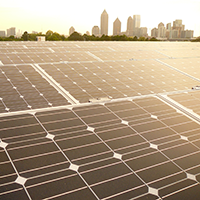
Georgia Legislature Passes Solar-Friendly Legislation
View the page for this story
The upfront costs of rooftop solar arrays can be prohibitive for homeowners. But as Georgia Solar Energy’s Brion Fitzpatrick tells host Steve Curwood, new legislation in the Peach State enables homeowners and small businesses to lease solar equipment and get energy credits for power fed to the grid, an incentive to go green. (05:10)
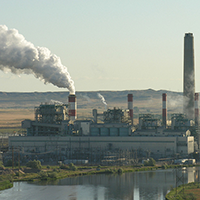
Beyond the Headlines
/ Peter DykstraView the page for this story
In this week’s trip beyond the headlines, Peter Dykstra tells host Steve Curwood about a very dirty use of clean green climate fund cash, religious leaders blessing climate action, and Walter Cronkite’s early warning about climate change. (04:05)
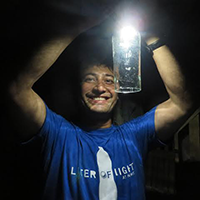
Liter of Light
/ Helen PalmerView the page for this story
Countries in the developing world often have limited access to affordable electricity, and extreme weather linked to climate change makes the problem worse. Now, disaster rehab specialist and social entrepreneur Illac Diaz’s “Liter of Light” project has created a clever, affordable solution, recycling discarded plastic water bottles into solar light bulbs. He showed his invention to Living on Earth’s Helen Palmer and explained how US school children are building the lights to help transform lives for people in energy-poor regions. (10:30)
Show Credits and Funders
Show Transcript
HOST: Steve Curwood
GUESTS: Mark Silby, Ramanan Laxminarayan, Jennifer Morgan, Brion Fitzpatrick,
REPORTERS: Carl Lindemann, Peter Dykstra, Helen Palmer
[THEME]
CURWOOD: From Public Radio International, this is Living on Earth.
[THEME]
CURWOOD: I'm Steve Curwood. Growing concerns about the use of antibiotics in livestock, and how it increases the dangers of superbugs for us.
LAXMINARAYAN: There is no such thing as your bacteria, which is separate from mine and different from your dog’s or different from the chicken that's being raised on the farm next door. It's one common pool of bacteria that's shared.
CURWOOD: Also the Liter of Light is providing illumination to people in energy poor parts of the world thanks to discarded plastic bottles – and training American kids how to cope if the grid goes down.
DIAZ: That’s what Liter of Light is, to go into schools where children and parents think it’s relevant for the children to be able to build their own streetlights and house lights. When they travel they take our kits with them and they can build it and donate it and they become our missionaries, our ambassadors of light.
CURWOOD: That and more this week on Living on Earth. Stick around.
[NEWSBREAK MUSIC: Boards Of Canada “Zoetrope” from “In A Beautiful Place Out In The Country” (Warp Records 2000)]
ANNOUNCER: Support for Living on Earth comes from United Technologies – innovating to make the world a better, more sustainable place to live.
Herbicides Can Boost Antibiotic Resistance

Herbicides are often applied to crop fields in bulk, in an effort to keep weeds from growing. (Photo: Chafer Machinery; Flickr CC BY 2.0)
CURWOOD: From the Jennifer and Ted Stanley Studios in Boston and PRI, this is Living on Earth. I’m Steve Curwood. We live in a chemical stew—everything from drugs in our water, to pollution in our air and pesticides in our food. In the US, drugs are tested for safety and toxicity but tests don’t replicate real world conditions with multiple exposures. Now scientists are trying to understand the broad effect drugs and other chemicals can have in combination. New research out of New Zealand has been testing how various herbicides including glyphosate or Roundup might increase the resistance of key bacteria to antibiotics, and the results are startling. For perspective and analysis we called up Mark Silby, who specializes in bacterial genetics at the University of Massachusetts, Dartmouth. Welcome, Professor Silby.
SILBY: Thank you very much.
CURWOOD: So, tell me what exactly did they do for this research?
SILBY: So in a nutshell, what was done here is ask a simple question about where the low concentrations of commonly used herbicides have unanticipated affects on the antibiotic resistance profiles of a couple bacteria called salmonella and E. coli, which are kind of models for two important pathogens of humans.
CURWOOD: So how did they do this? How did they find that herbicides were leading to antibiotic resistance?
SILBY: So you grow your bacteria in flasks with culture medium that allows them to grow really, really well. What they've done is several treatments. So one treatment you do nothing to them. This is your baseline just to show you how many bacteria are surviving in your flask. Then they have a treatment where they have herbicide by itself added to the flask, they have antibiotic added to the flask, and then they have a combination antibiotic and herbicide added to the flask, and then what you do is you simply take bacterial samples out of there and determine how many of them stay alive. By doing that you can see whether or not the antibiotic was effective or ineffective at killing.
CURWOOD: Which antibiotics were used for this research? Which ones were checked?
SILBY: So they used a range of antibiotics from several different classes that represent frequently used antibiotics in medicine such as ampicillin, which is like penicillin, tetracycline which is the first in the family of antibiotics which a lot of people might know for use against acne, and then Cipro, which a lot of people knew about Cipro after 911 and all the anthrax attacks.
CURWOOD: What they find?
SILBY: So they found that when they expose these bacteria to low concentrations of sub-inhibitory concentrations of the herbicide, they saw various changes in the resistance profile of the two bacteria, and that sometimes resistance goes dramatically up and in fact sometimes it goes dramatically down. Very little stayed the same.
CURWOOD: How is it that sometimes it made the bacteria more susceptible to antibiotics?
SILBY: So that's a good question, I don't think we really know the answer to that yet because we don't know the full story of what's happening to these bacteria when they're exposed to these low concentrations of herbicide.
CURWOOD: How is it that herbicides can cause antibiotic resistance?
SILBY: So, these herbicides don't cause permanent antibiotic resistance. They cause a temporary increase in resistance. So the way this works is that the bacteria are exposed to the herbicide and what they see is not something that's a weed-killer. They see a toxin. The way they respond to the toxin is by changing their physiology and they do this by increasing their ability to pump nasty stuff out of their cells. When the toxin enters the cell, if it stays there, it might kill them. So they have a whole bunch of little pumps, which are there specifically to try and remove the toxin from the cell before it can do any damage. Now, what happens in the case when you both herbicides and antibiotics present at the same time, is that those pumps not only remove the herbicide from the cell, they also remove the antibiotic before the antibiotic can effectively kill that cell.
CURWOOD: So, how powerful were these antibiotics in inducing antibiotic resistance in these bacteria?

Antibiotic resistance tests of E. coli on an agar medium show how different dosages of antibiotic inhibit bacterial growth. (Photo: Wellcome Images; Flickr CC BY-NC-ND 2.0)
SILBY: The response in the bacteria was varied, and also the response to different antibiotics was different, so it's quite nuanced. One of the antibiotics used in combination with Roundup showed that Roundup increased its tolerance by 5.8 fold, which is a fairly large change, and several of the responses were between 1.2 and 3.3 fold which is reasonably significant to make a difference to the susceptibility of these bacteria.
CURWOOD: Mark, what does this mean for the overall health of people who consume foods where these herbicides have been used and where there might be bacterial exposure?
SILBY: Well, we have to remember this was a laboratory study, not a clinical study. So, the feeling is that this is probably not a big problem right now for people consuming food because the concentrations of herbicides used here were well above the limit that's allowable as a residue on food that you ingest. Longer term, what we worry about is, whenever you see even a transient increase in antibiotic resistance, does that give those bacteria an opportunity to survive for longer, which means that they have more opportunity to develop a real strong and genetically coded resistance which would be permanent.
CURWOOD: Mark, what's the takeaway message here?
SILBY: The take-home here is really tricky in a way, because we see specific reactions for the two different species, we see different reactions for different herbicides, and we see different reactions to the different antibiotics, which tells us we can't just do one experiment with one single species and generalize in terms of safety. So we need to do more work. I think most of this is telling us is that we have to think more broadly. So, we have to think about biology when we assess risk, we have to think about unanticipated consequences of what we do in our environment so we can manage risk and the idea in terms of safety in humans is a little bit obvious I think, but safety in terms of what we do to our environment is a much harder question to answer and we haven't done the experiments to find out what's happening yet.
CURWOOD: Mark Silby is an expert in bacterial genetics at the University of Massachusetts, Dartmouth. Thanks for taking the time with us today Professor Silby.
SILBY: Great. Thanks very much for having me.
CURWOOD: We asked Monsanto to comment, but they did not get back to us in time for our deadline.
After the program was recorded, Monsanto sent us the following statement:
We are taking a closer look at this study, but it is very complicated and nearly impossible to discern if these formulated herbicides have any impact within this study. It is absolutely critical that the authors test the formulated herbicide alone, as well as the active ingredient alone, to assess the individual contributions of each variable.
In the past few years, several articles summarizing research related to glyphosate safety have been written and published in peer-reviewed journals. These six articles continue to support the 40-year history of safe use of glyphosate-based herbicides. They also add additional weight to one of the most extensive human health, safety and environmental databases ever compiled for a pesticide product.
For more information on this, contact Charla Marie Lord at Monsanto. charla.marie.lord@monsanto.com
Related links:
- Read the study published in The American Society for Microbiology
- More about Mark Silby and his research in microbial biology and genetics
- Monsanto
Growth In Livestock Antibiotics Raises Risks For Humans

Non-therapeutic antibiotic use in livestock allows farmers to keep pigs, cows, and chickens in less hygienic conditions without getting sick. (Photo: Bigstockphoto)
CURWOOD: President Obama has just announced a five-year plan to combat rising antibiotic resistance – and one particular area of focus is the overuse of these drugs in the livestock industry. A recent study documents how the use of antibiotics in farm animals is rising around the world, especially in less affluent nations. Joining us now to discuss the problem is the lead author and Princeton Professor Ramanan Laxminarayan.
LAXMINARAYAN: Way back in the 1950s, a bunch of scientists discovered that by giving antibiotics in very small concentrations to livestock, to poultry, to hogs, to cattle, that they could grow much faster and disease could be prevented and you could bring them to market a lot sooner. Now, all this was helpful back in the day when there was an increased demand for animal protein, particularly in the post-World War period. And over time these practices continued, but the use of antibiotics in sub-therapeutic concentrations has also been known to increase resistance in bacteria.
CURWOOD: Now, you've looked at how this practice of feeding antibiotics to livestock to enhance production is playing out around the world and the question of antibiotic resistance. What did you find?
LAXMINARAYAN: So we found, first of all, that the practice of antibiotic use in sub-therapeutic concentrations is not a developed country phenomenon any more. It's now widespread in countries like Kenya, South Africa, India, China and the demand for animal protein in these countries is increasing at a prodigious pace. We estimated at about a consumption in the livestock industry for the world, particularly in low-and-middle income countries and we estimate that this use could go up by about 67 percent just between 2010 and 2030, which is a remarkable increase given that use right now is at a fairly high figure of 63,000 tons. Two-thirds of that increase is because of the increase in demand of animal protein and about a third is because of the shift to more intensive production systems that need antibiotics if it's not a modern facility.

The use of antibiotics for livestock is on the rise, particularly in China and India. (Photo: Bigstockphoto)
CURWOOD: So where are the places where you seeing this really rapid rise in the use of antibiotics in agriculture?
LAXMINARAYAN: So we see the rapid rise in places where demand for animal protein is increasing the most. So that is in large parts of China where populations are pretty high at the moment and where people are getting wealthier. And one thing which people do when they get wealthier is to eat more meat. In fact it is a sign of actual wealth in terms of being able to afford to eat more meat. We also see this in parts of India, particularly in coastal South India, where again rising incomes are leading to increased meat consumption.
CURWOOD: Isn't there kind of a yuck factor here if people know that these animals are being raised in such filth that they must have antibiotics? It feels kind of unappetizing?
LAXMINARAYAN: Well, the fact is that most people don't know that their animals are fed antibiotics on a constant basis. In fact, I would suspect that is true even of the US population. It's only now that people are beginning to realize that there is such a thing as antibiotic free meat, which then means that the rest of the meat must not be antibiotic free. I don't think a lot of people realize that this phenomenon of feeding the animals day after day in low concentrations is quite widespread. I think this is a well-kept secret.
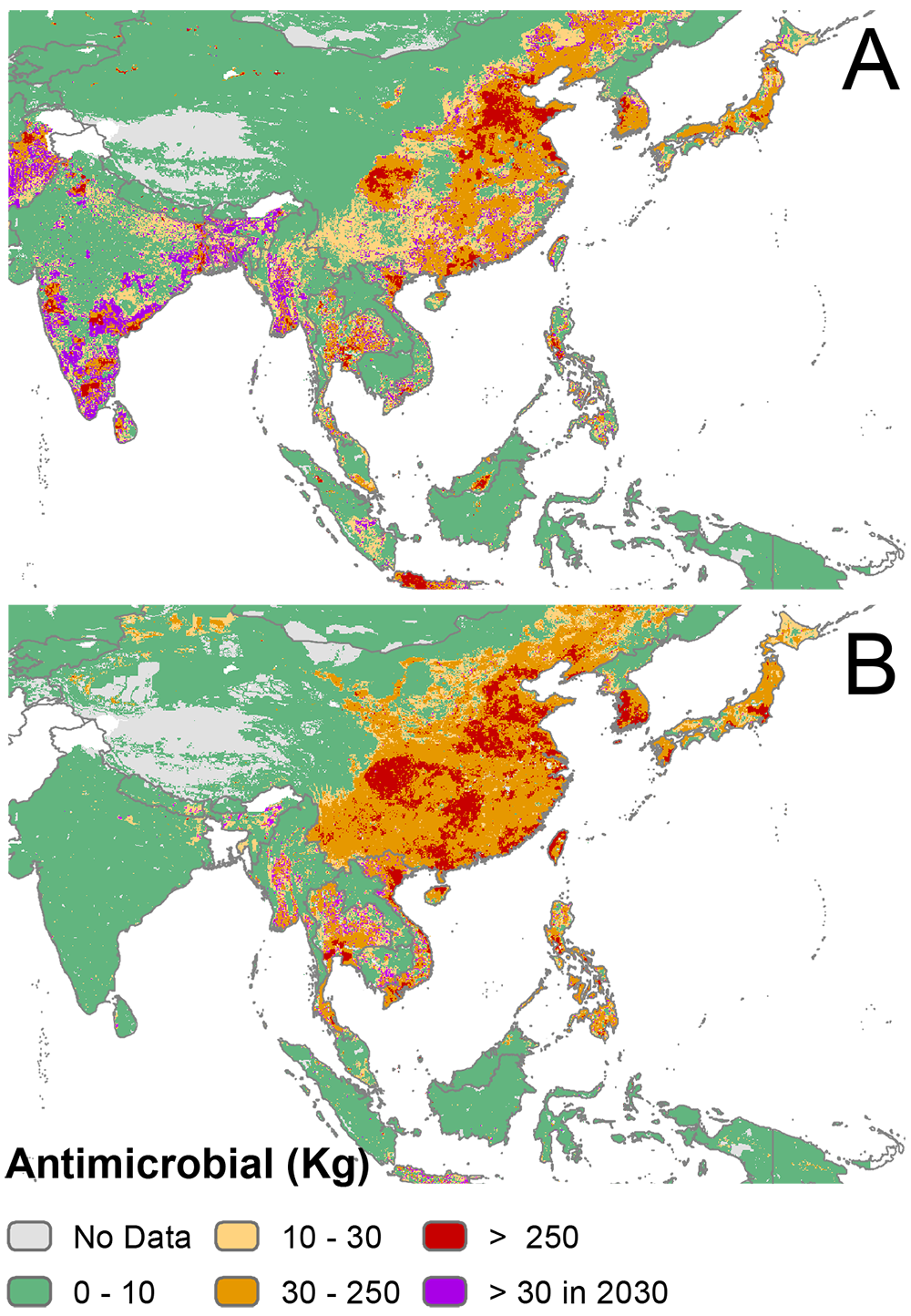
Antibiotic consumption by chickens (Image A) and pigs (Image B) across Asia as of 2010. Purple areas are where consumption is expected to increase significantly by 2030—most noticeably, use in chickens in India. (Photo: PNAS)
CURWOOD: Talk to me a bit, professor, how the use of antibiotics for livestock has an effect on human health?
LAXMINARAYAN: So any use of antibiotics, whether in humans or in animals places selection pressure for resistant bacteria to thrive. So this is just Darwinian selection. We kill off the sensitive bacteria; we let the resistant ones survive. So the same mechanisms are operating in bacteria whether they're in humans and animals. And although we think of the bacteria in our bodies as our own, we actually have far more bacteria in our bodies than we have even human cells and we essentially inhabit the world of bacteria. So we're passing these bacteria back and forth to the animals, back to ourselves, and it's a free flow of both the bacteria as well as these genes that encode for resistance. So there is no such thing is your bacteria which is separate from mine and different from your dog's or different from the chicken that's being raised on the farm next door. It's one common pool of bacteria that's shared. So when we use antibiotics in large volumes, whether in humans or animals, we're essentially putting ourselves at risk for having infections that are caused by organisms that don't respond to antibiotics.
CURWOOD: And what about treating infections? What are some of the particular diseases that you're especially concerned about?

Antibiotic use per kilogram of animal species in developed countries. (Photo: PNAS)
LAXMINARAYAN: So, bacterial infections typically cause one of three things for the most part. So they either cause urinary tract infections, UTIs that a lot of people are familiar with, pneumonia, or sepsis, which is bloodstream infections, and all three of these are caused by a wide range of bacteria. Nearly all of which are resistant to some and some of these to all of the antibiotics that we have right now. So when you hear about us entering a post antibiotic era it's because we now actually have infections in our hospitals that no antibiotic will cure and there's not very much a doctor can do for the patient. But what a lot of people don't realize is that common procedures whether this is having a biopsy or having a C-section, we need antibiotics in order to be able to perform these procedures because without antibiotics there is a risk of infection which would then make the outcomes for these procedures a lot worse than they are right now. So much of what constitutes modern medicine really depends on our ability to be able to have an efficient way to prevent infections and the best way we know how is through antibiotics.
CURWOOD: How is this affecting people seeking treatment for infections in less developed countries at this point?
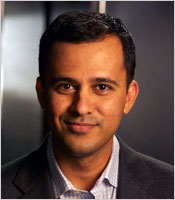
Ramanan Laxminarayan (Photo: Princeton University)
LAXMINARAYAN: So unlike those living in developed countries where if the first antibiotic didn't work for you, you could try a second one or a third one - and the third one might cost hundreds of dollars, perhaps even thousands of dollars - the average patient in a low-income country probably can't afford the antibiotic that probably costs more than a dollar a dose, so maybe even in a couple dollars a dose. So the loss of antibiotic effectiveness is far more profound in terms of impacts on health in low-and-middle income countries because of the inability to be able to afford more expensive antibiotics. Now increasing access to antibiotics for these populations is a good thing because these folks never had antibiotics to begin with to treat infections. But the tragedy of resistance is that when these folks actually get wealthy enough to be able to afford an antibiotic, these drugs won't work.
CURWOOD: Professor Ramanan Laxminarayan is a Senior Research Scholar at the Princeton Environmental Institute in Princeton, New Jersey. Thanks for joining us.
LAXMINARAYAN: My pleasure.
CURWOOD: The Professor’s research suggests it would cost little to reduce antibiotic use in animals in the US, but that’s less true in the challenging conditions of the developing world. There's a link to all this research on our website LOE.org.
Related links:
- Listen to Ramanan Laxminarayan’s TED Talk on antibiotic resistance
- Read the original article on the rise of antibiotics in PNAS
- Dr. Laxminarayan’s paper on the cost of withdrawing antibiotics from the livestock sector
[MUSIC: Oliver Mtukudzi, Dzoka Uyamwe, Tuku Music – Zimbabwe, 1999]
CURWOOD: Coming up...the US lays out its promises to cut global warming gas emissions well ahead of the most vital climate summit in five years. Stay tuned to Living on Earth.
[CUTAWAY MUSIC: Alberto Mesirca, Farewell to Stromness, British Guitar Music Paladino 2012]
US Advances Climate Plan For Paris Summit
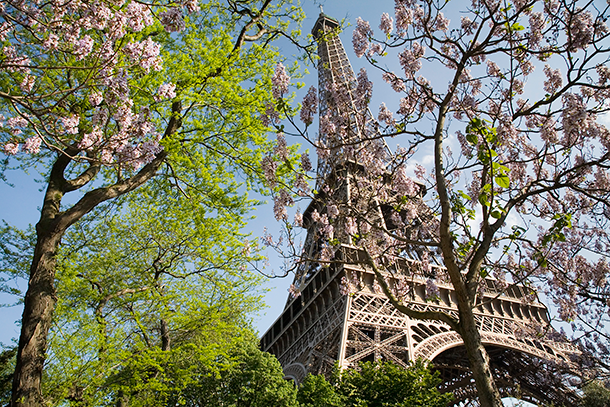
Observers are calling the 2015 climate negotiations in Paris an important moment in the history of the planet. (Photo: Jorge Royan; CC BY 3.0)
CURWOOD: It’s Living on Earth. I’m Steve Curwood. December in Paris is not quite like April in Paris, but it is expected to become key this year in the global push to fight climate disruption. On March 31, the United States released its pledges to reduce emissions well ahead of the climate summit in the city of light, the most important such session since negotiations unraveled in Copenhagen in 2009. And the United States was among the first nations to reveal its commitments. Here to discuss where we stand is Jennifer Morgan, Director of the Climate Program at the World Resources Institute. Welcome back to Living on Earth, Jennifer.
MORGAN: Thanks, it's great to be here.
CURWOOD: Now, the US finds itself in a different position than in the run-up to the previous major conference there in Copenhagen where in the early days of the Obama administration there wasn't even a task force to figure out what the US position would be. To what extent is the United States, is America, leading this charge now?
MORGAN: The US, I think, is very much leading the charge; they've put forward a serious offer. The President has asked every single secretary to look at what he or she can do to reduce emissions with their executive authority. They've put their offer forward early and transparently. I think it's a big priority for the President's second term, which is great.
CURWOOD: So talk about the US plan. How much of the emissions is the United States committed to reduce?
MORGAN: They've committed to reduce 26 to 28 percent below 2005 levels by 2025. That's about a doubling of what they've done thus far. It includes all greenhouse gas emissions, a hundred percent of them. They have a list of the various standards and laws and rules that they're going to use, that they have authority to use to meet that target making power plants more efficient tackling methane using fuel economy standards for cars and trucks, appliances. It's a pretty robust plan, I think.
CURWOOD: And President Obama doesn't need Congress at all to do this apparently.
MORGAN: He doesn't. What he is doing is using his executive authority which was granted to him by the Supreme Court that found that greenhouse gases are pollutants and therefore the Clean Air Act must regulate those sources and so with this plan can be done without Congress, but clearly it would be better if Congress was engaged in helping out on tackling climate change.
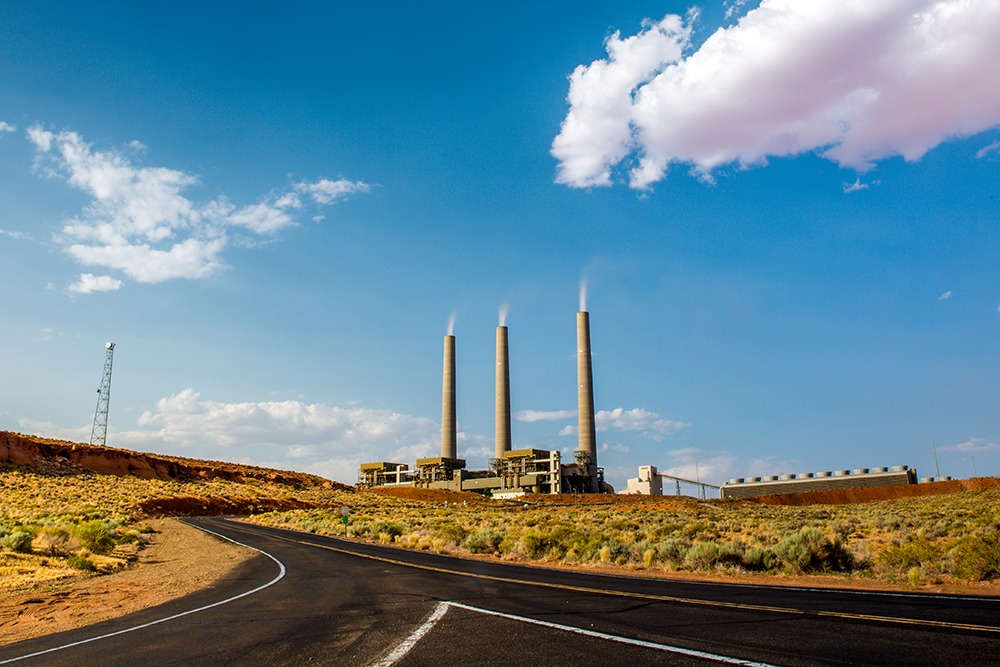
Much of the US’ energy plan will rely on President Obama’s clean power plant rule. (Photo: Bigstockphoto)
CURWOOD: Well, without Congress though the United States isn't able to say that we would simply buy emissions from elsewhere, that is trade emissions that we have to do everything at home. Some would say that maybe puts us in a stronger position.
MORGAN: Well, I think it is very interesting, and it sends a strong signal that the US is decarbonizing its economy domestically, that there will be much less coal used, more renewables used. It's really calling on American ingenuity and innovation to solve the problem and not trying to go and buy offset credits somewhere else.
CURWOOD: So on the Jennifer Morgan World Resources Institute's scale of weak to ambitious, how strong is the United States plan, let's say from one to ten?
MORGAN: I would give it a good seven, seven to eight. I mean, it does set a longer-term goal of getting out to about 80 percent reductions by 2050. There, more is needed. Climate change is happening now and we need to actually shift and have deep decarbonization of our entire economies, so over the longer term, greater ambition is going to be needed.
CURWOOD: Talk to me about some of the other countries here. Who else has put forward an ambitious plan?
MORGAN: Well, I think we've seen serious offers from Switzerland, I think most importantly from European Union. They've said they're going to reduce their emissions by at least 40 percent below 1990 levels by 2030, so they're really staying the course. Renewables is the only energy source that's going to be growing in Europe in the future, and very importantly, Mexico just tabled its national plan to peak its emissions in 2026, set up a Climate Policy Council with United States, also putting in a set of measures to harmonize standards. So I think the standard you see in the US plan I would expect to be a conversation now with Mexico, and the first developing country to get out there in front of many other developed countries in fact.
CURWOOD: How's the rest of Latin America faring? I understand you were recently in Brazil?
MORGAN: Latin America is a fascinating place. There's so much dynamism there and you see the plans will come in, I think, from Chile, from Peru, from Columbia, where they, from what I understand, see that acting on climate change is much less expensive then dealing with the costs of the impacts of climate change. Brazil is in a unique situation, it's reduced its deforestation omissions quite a lot, but it could start building coal in Brazil instead of sticking with its low carbon energy sources. So there, my hope would be that they'll follow the pathway of China and India and put in place ambitious targets on wind and solar so that they don't make the mistakes of other countries.
CURWOOD: What about China? China is the world’s largest emitter, and they didn't have a plan to hit the March deadline, but as I understand it they will have something by June? How concerning is that delay and how strong do you think their approach will be?
MORGAN: Well, China's big step on the world stage was in the US-China agreement that came out in November of last year where they indicated that they were going to work to peak their emissions by the latest 2030 and aim to do so beforehand. They put out a big commitment on non-fossil energy sources and are really I think getting in more detail of what will go into their plan and that's why they're taking a little bit longer. As long as that comes out in June, July, I'm not worried about it. My understanding is you know they have so much going on also on pilots on emissions trading, on efficiency, they're really trying to make that a robust plan, which is just immensely important. The way that China goes in the future is clearly fundamental for whether we're able to really tackle this problem or not.
CURWOOD: So from your perspective where do we stand now heading into these really important negotiations in Paris come December? In other words, how optimistic are you that the world is going to get something meaningful done?
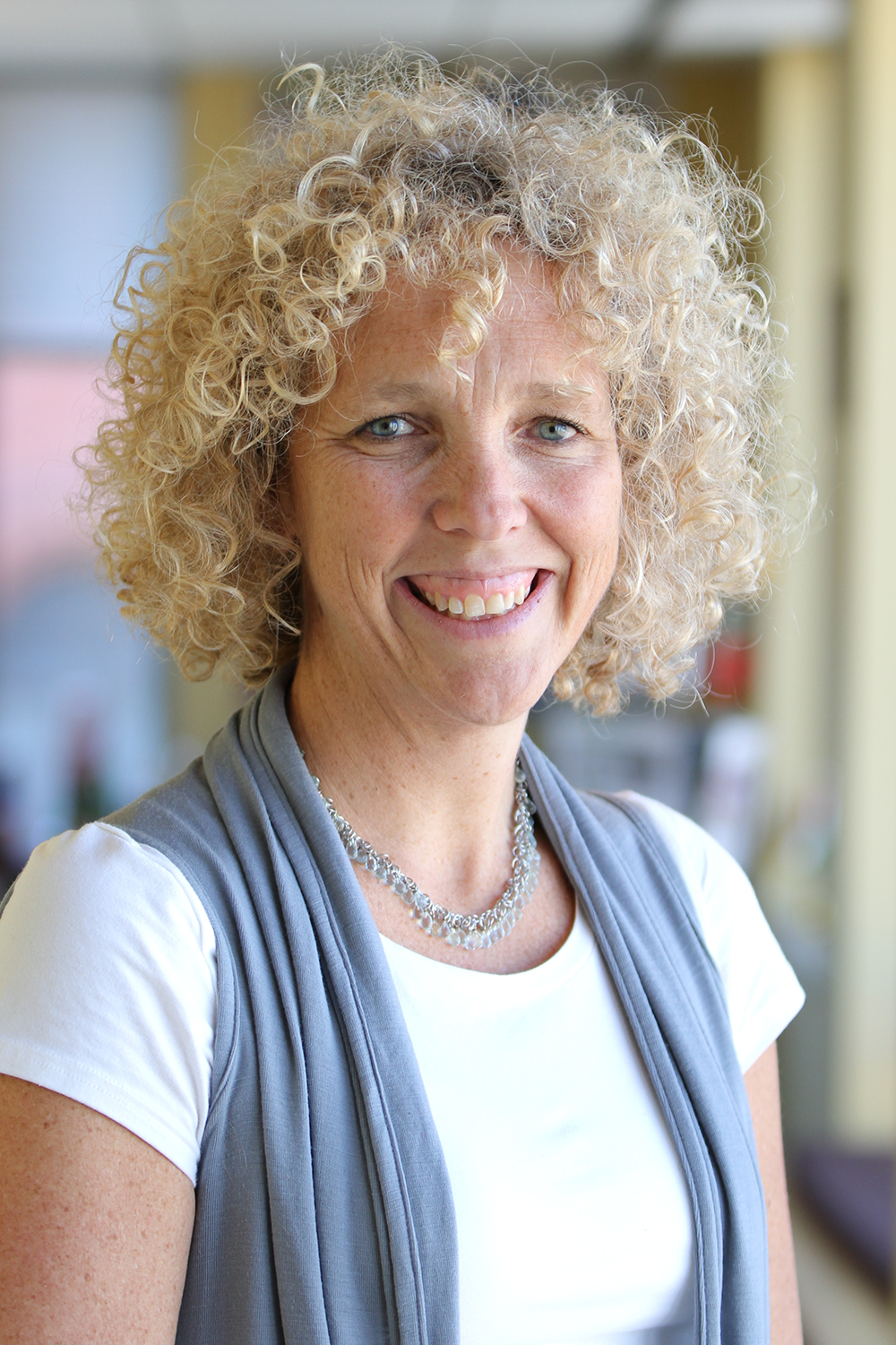
Jennifer Morgan (Photo: World Resources Institute)
MORGAN: Well, I think where we stand is that you're seeing a level of seriousness by major economies coming forward with their plans, what they are going to do. I think the negotiations will intensify. I'm optimistic that there will be an agreement in Paris. I think, though, it's got to be a really hard number of months to get this done. It will require heads of state engagements so that that agreement can be as robust as possible, that it can send a signal to the world that the future is low carbon and that it's got to happen faster and at greater scale than people had expected beforehand.
CURWOOD: Jennifer Morgan is Director of the Climate Program at the World Resources Institute. Thanks for joining us today.
MORGAN: Thank you.
Related links:
- Read more about the United States’ emissions plan
- Plans from other countries at the UNFCCC website
[MUSIC: Vince Giordano’s Nighthawks, Everybody Loves my Baby, Boardwalk Empire Vol 2 ABKCO Music, 2013]
Greening the Tea Party
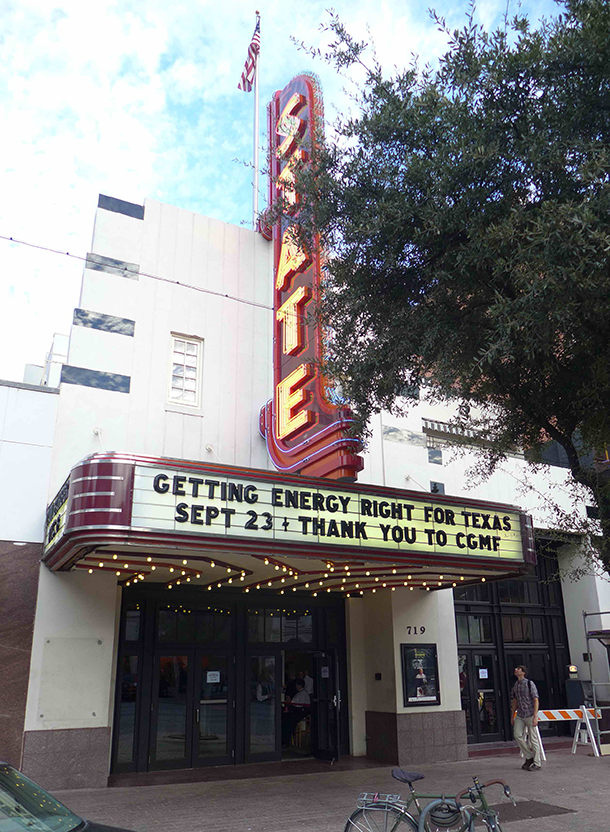
“Green” Tea Party members and conservation-minded Republicans attended the “a fresh conservative take on energy policy” summit at the Paramount Theater in Austin, Texas on September 23rd, 2014. (Photo: Carl Lindemann)
CURWOOD: April is the month that brings us Earth Day – celebrating its 45th birthday this year. We’re not sure whether that makes it confident and mature, or facing a midlife crisis – either way we’ve tried to mark this month by checking in on some our previous stories to find out what’s happened since. Usually we’ve gone back several years – but a new development caught our attention and persuaded us to revisit a fairly recent story Carl Lindemann of the Texas Observer brought us from Austin – about the rise of green thinking among some conservatives.
LINDEMANN: It's been more than a century since Republican Teddy Roosevelt made conservation a conservative cause. But what's old is new for Debbie Doolie, the founder of the Georgia-based Green Tea Coalition and national coordinator of the Tea Party Patriots. Recently, Dooley and a crew of fellow conservative activists brought their message deep in the heart of Texas at a conference billed as a "fresh conservative take on clean energy."
DOOLEY: I'm a staunch, right-wing radical conservative and I believe - I know this is something many don't agree with - but I believe conservation is a conservative principle.
LINDEMANN: These clean energy conservatives are looking to break some Republican taboos for the cause of free markets and national security.
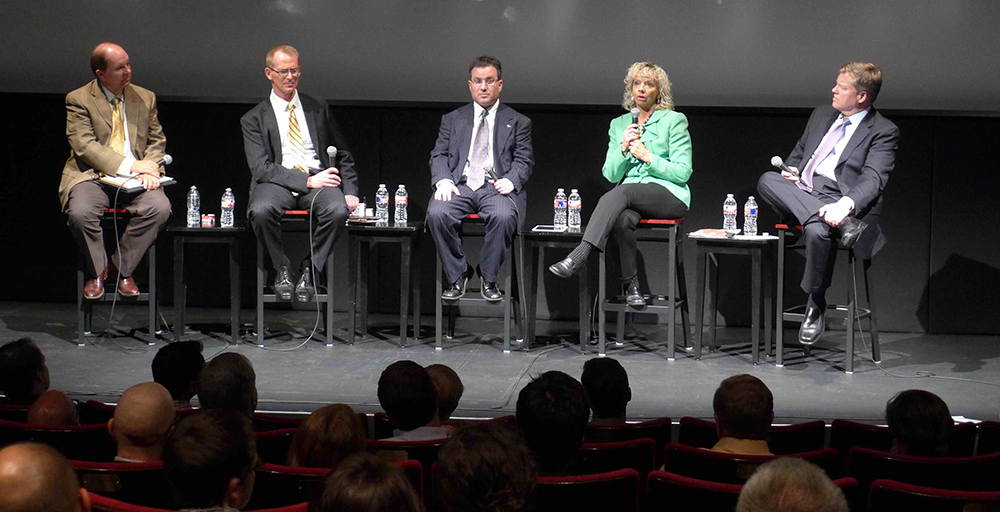
Summit panelists (from left): Former Texas Republican Senator and head of the Texas Clean Energy Coalition Kip Averitt, former South Carolina Congressman Bob Inglis, Eli Lehrer of conservative think tank R Street Institute, founder of the Green Tea Coalition and national coordinator for the Tea Party Patriots Debbie Dooley and Republican strategist Tucker Eskew. (Photo: Carl Lindemann)
DOOLEY: Believe it or not, coal and nuclear have received billions of dollars in subsidies. But unfortunately, you don't hear conservatives talk about that. They just point to the renewables.
LINDEMANN: Dooley also argues that moving towards a decentralized power grid is key for national security. Rooftop solar on millions of homes is a tough target for terrorists, unlike traditional power plants, oil refineries and the like.
Dooley's coalition has brought together an unlikely assortment of groups that include the Sierra Club and Georgia right to life. Their stand for solar has also taken them against what's typically a Tea Party ally - the Koch-funded Americans for Prosperity.
Here, Dooley says, the Koch brothers have lost sight of core conservative values because of their fossil fueled interests. The key to beating such a well-funded adversary is communicating the free market/national security message effectively.

Debbie Dooley advocates for clean energy, helping to alleviate the climate crisis and national security issues, while working in a free market system. (Photo: Carl Lindemann)
DOOLEY: When our public service commissioners were attacked for wanting Georgia Power to add more solar, they were attacked by AFP in Georgia, and I sent out an email and I had their back, and I educated conservatives on the conservative message as far as decentralized energy and solar. And we won that!
LINDEMANN: Should this take on clean energy sweep the Tea Party nationally, it would mark a seismic shift. Kip Averitt, a former Texas Republican state Sen. who now heads the Texas Clean Energy Coalition says such a shakeup in the political landscape should be possible given the tremendous success there for wind and solar. But there's work to be done
AVERITT: You've got to set our conservatives free. You have to tell them it's OK to do the right thing. They have to understand that mom and dad back home are engaged and paying attention to clean energy policy. Our Republicans in Texas...we have a whole boatload of them that want to do the right thing, but they have to tip-toe around it, they get timid, they get scared because they're, quite frankly, afraid of the tea party.
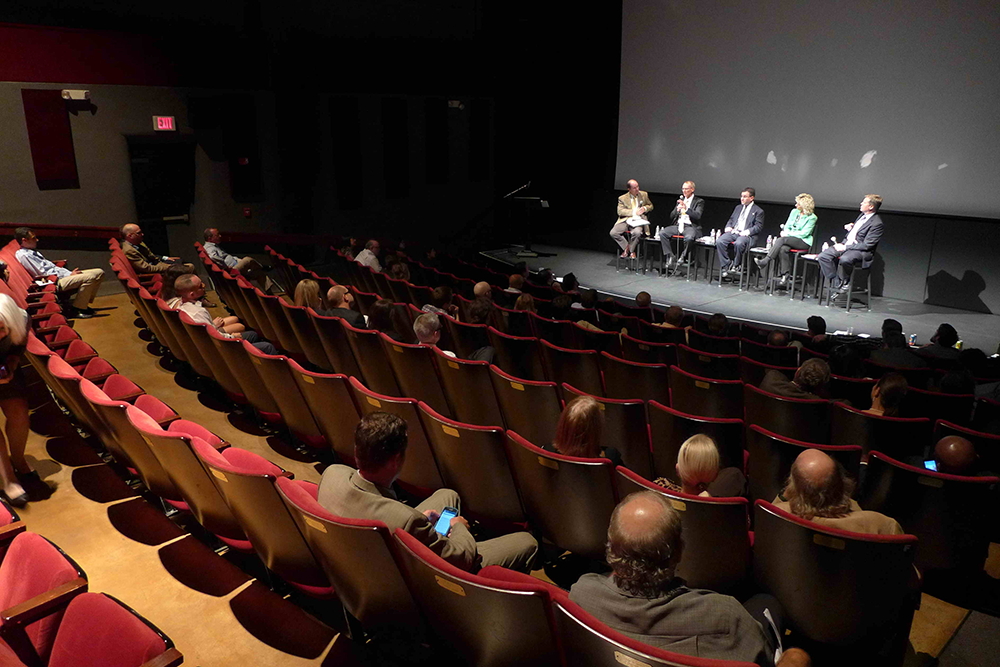
Only about 60 people turned out for the summit, but Tucker Eskew believes that more “green conservatives” exist and expects the trend to catch on. (Photo: Carl Lindemann)
LINDEMANN: There's more here to fear than fear itself as former six-term Congressman Bob Inglis, a Republican from South Carolina, can attest. He lost to a Tea Party challenger in the GOP primary in 2010. Now, he directs the Energy & Enterprise Initiative at George Washington University. He says that green conservatives combine what he calls "energy optimism" with "climate realism," a hybrid that can get great mileage. Inglis says the message they need to drive home is that a truly free market is not just about cutting cash subsidies.
INGLIS: Maybe the biggest subsidy of them all is being able to belch and burn in the trash dump of the sky without any tipping fee. That's a hard message because "what are you talking about? There's no trash dump in the sky!" Oh no, there is. And we don't charge for emissions.
LINDEMANN: Calling for government cuts is another conservative rallying cry. Eli Lehrer co-founder and president of the R Street Institute, leads what aims to be a new breed of conservative think tank. Lehrer pointed to how their Green Scissors campaign serves environmentalism by targeting government projects that harm the environment.
LEHRER: The costs that government imposes on our environment, the amount that we pay to do environmental damage is enormous.
LINDEMANN: The "fresh conservative take on clean energy" conference in Austin, Texas didn't draw much of a crowd. That could make the gathering all the more memorable according to Tucker Eskew. Eskew is a top Republican strategist, and no stranger to difficult challenges. He was the go-to guy to tutor Sarah Palin on being a vice-presidential candidate in 2008. He says, being a clean energy conservative may be coming into style.
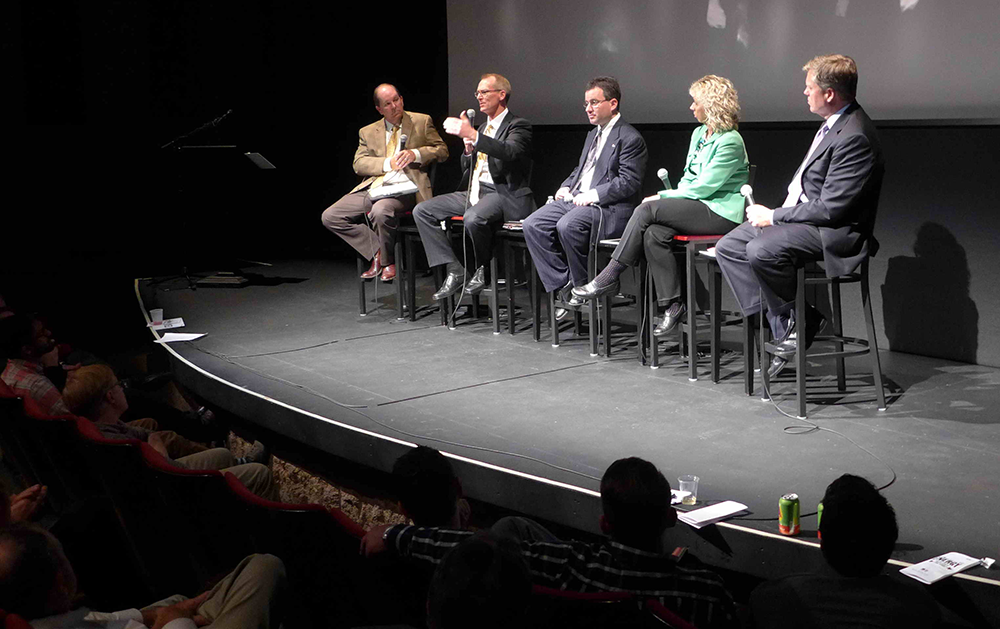
Former South Carolina Congressman Bob Inglis says, “What we’re looking for are energy optimists and climate realists.” (Photo: Carl Lindemann)
ESKEW: Do you remember the saying 'I was country before country was cool’? I think there was even a song. Some Republicans picked that up before long and they were conservative before conservative was cool. Maybe, one day, we'll look back on this event and realize we were clean energy conservatives before it was cool.
LINDEMANN: Meanwhile, as cool as green can be, the shale energy boom remains red hot in Texas and elsewhere firing up the economy by generating tens of billions of dollars. Until that cools, clean energy conservatives will have to do their best not to be left out in the cold.
For Living on Earth, I’m Carl Lindemann in Austin, Texas.
Related links:
- Read Carl Lindemann’s story on the Tea Party’s conservative green activism in the Texas Observer.
- Kip Averitt's group, Texas Clean Energy Coalition
- Former Texas Republican state Sen. Kip Averitt heads the Green Tea Coalition along with its founder and leader of the Tea Party Patriots, Debbie Dooley
- Former South Carolina Republican Congressman Bob Inglis’ Energy & Enterprise Initiative
- Eli Lehrer’s think-tank, R Street Institute
- Green Scissors targets wasteful and environmentally harmful spending by government projects
Georgia Legislature Passes Solar-Friendly Legislation
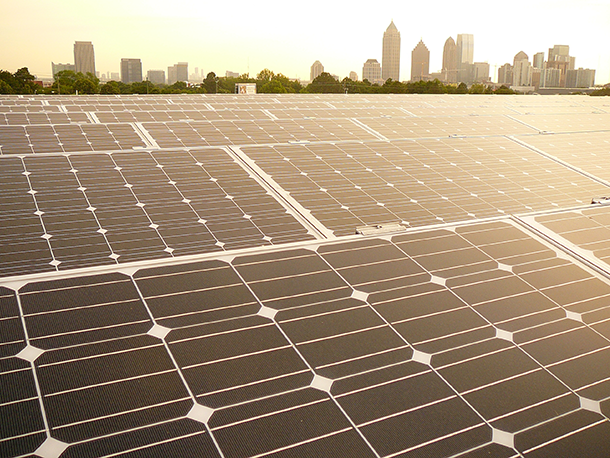
The Georgia legislature recently passed a bill enabling homeowners and small businesses to lease solar equipment from companies during a 10- to 20-year payback period. Governor Nathan Deal is expected to sign the bill into law. (Photo: courtesy of Inman Solar)
CURWOOD: Well the clean energy conservatives may still be having a hard time gaining traction in Texas – but in another southern Republican stronghold, Georgia, renewable energy is celebrating a victory, thanks to support from the Green Tea coalition, among others. But solar incentives can make the difference, and Georgia’s state Legislature recently passed a bill that makes it easier for homeowners to lease solar equipment and then get credit for any excess power generated that goes back through the grid to electric utilities. We got in touch with Brion Fitzpatrick, Chairman of the Georgia Solar Energy Association to find out what will change with the legislation.
FITZPATRICK: What consumers and essentially homeowners are going to be able to do is work with a solar company that would provide solar panels on their house, 100 percent free of charge perhaps, and then would sell them the electricity for slightly less than what they're currently paying, and this, of course, would only be generated only the day hours, there would be no storage, and so they would be able to sign a power purchasing agreement with that company.
CURWOOD: In that case, Brion, who owns the solar panels?
FITZPATRICK: The solar panels will be financed to the homeowner. Similar to how you purchase a car, you're paying off that financing. The solar panels will change ownership at some point during that financing structure from the solar panel installer over to the homeowner.
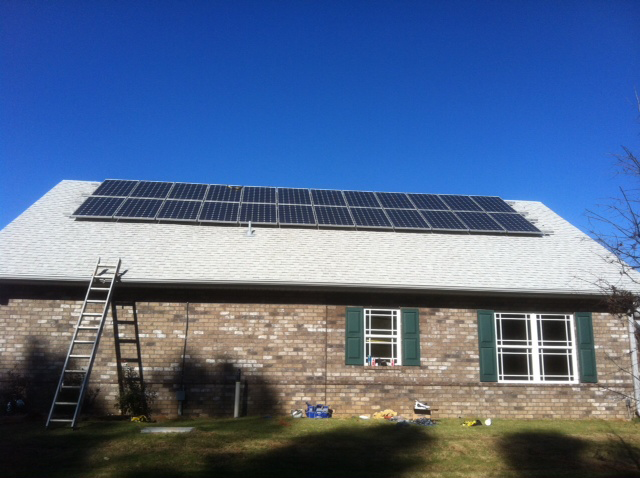
The state of Georgia went from being ranked 26th in the nation to 7th in solar capacity in the span of less than three years. (Photo: courtesy of Inman Solar)
CURWOOD: Tell me, what does Georgia's energy portfolio look like today?
FITZPATRICK: Well, Georgia power and utility companies, their stack includes coal-fired power plants, nuclear, hydro, biomass, as well as some solar and other renewable energies. And so, the majority of the power is coal and nuclear, but they're working hard to bring in more renewables and cleaner power.
CURWOOD: So, Brion, how has solar been doing up to the point of this legislation?
FITZPATRICK: Yeah, I'm glad you asked that. Solar has been on a steady rise in Georgia for the past five or six years. There's been strong advocate groups out there, advocating for more solar as there have been in other states, our public service commission has been attentive to the needs and benefits of solar energy, and it's actually helped Georgia go from 26th in the nation to seventh in the nation in the past three years.
CURWOOD: Now, in a number of states, utilities have been pushing back against net metering which allows solar customers to get compensation for the electricity that they generate, at least get credit for it, saying that it forces other customers of their utilities to pay higher rates and in some cases utilities want solar customers to pay surcharges on their bill. What kind of risk is there for that in Georgia do you think?
FITZPATRICK: Well, I think the states, that's all part of the learning curve that goes towards knowing more and understanding what the true value of solar electricity is to the electrical grid. Utility companies spend a lot of money on lowering their risk factor for possible blackouts, so they are there when we need them to be. Solar is a benefit to that. It's helping them shave their peak demand for those hot summer Georgia days when everyone's got their AC units on, they will be able to have some satisfaction knowing that that customer who is using their AC is not only relying on the electrical grid but they're also pulling from their own solar arrays. So this will help lower the risk of any blackouts. In the past it's been seen as damaging their business model, but now I believe that they are understanding that this is a benefit to their business model in helping to lift some of the costs off what they would normally spend on risk management.
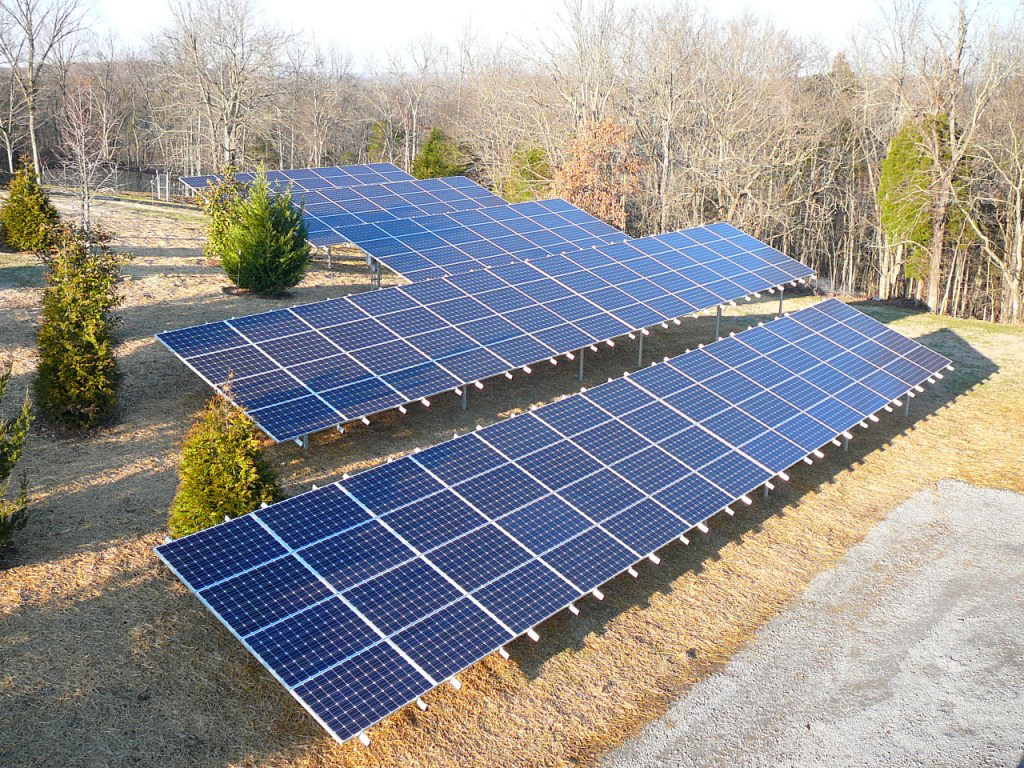
The bill would allow solar companies to finance new solar arrays on homes and small businesses, much like a financing at a car dealership. (Photo: courtesy of Inman Solar)
CURWOOD: So, what do you expect Georgia's electricity portfolio to look like in 10 or 20 years?
FITZPATRICK: That's a very good question. What we've seen from other states is that this is going to grow on the systems on small businesses and it's going to grow on solar arrays for homeowners. As far as the energy makeup, it's hard to speculate how big this is going to get. A lot of what this new financing mechanism is going to be providing to the state, it's going to be based on what those individual customers are paying for power. There's multiple different rate schedules, so, some of the large commercial users, it may be less advantageous for them to finance their systems as it would be for some of the smaller users or homeowners.
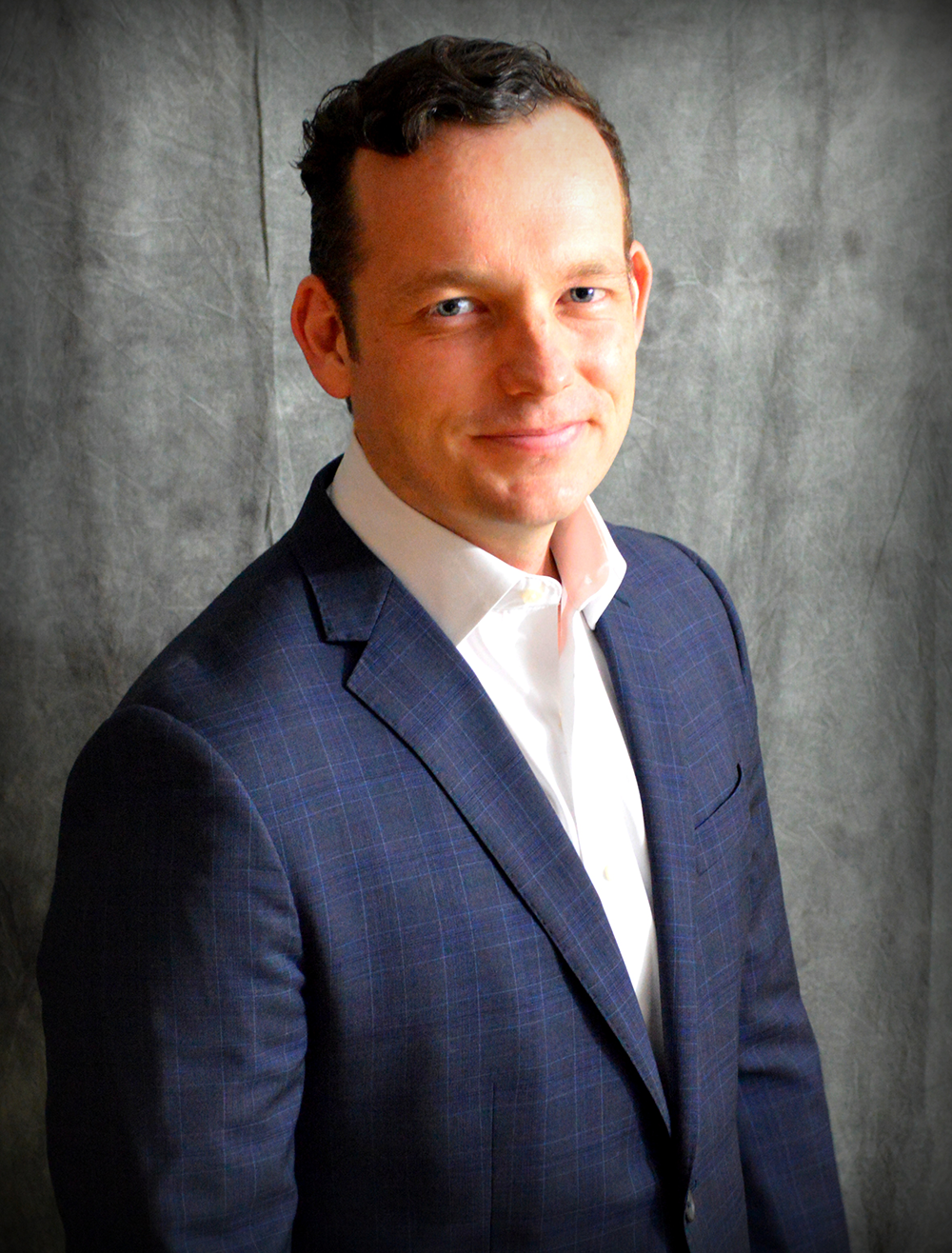
Brion Fitzpatrick is Chairman of the Georgia Solar Energy Association, a nonprofit advocacy group based in Atlanta. (Photo: courtesy of Inman Solar)
CURWOOD: Now, this legislation is a bipartisan effort. Republican lead sponsor, you have Mike Dudgeon. In what ways does it appeal to both democrats and republicans, in Georgia and well, around the nation?
FITZPATRICK: Now, this isn't really a partisan issue. This is the citizens of Georgia where everyone has an opportunity to benefit. This is a property rights issue. This goes back to our core values. Everybody should have the opportunity to lease solar panels for their roof. I mean, we all have the equal opportunity to go down to our local car dealership and lease a car and we do this with our homes. These are the things that we use to build our lives and to grow our wealth, to grow our independence for ourselves, and I think that's an important ideal for both sides of the aisle.
CURWOOD: Brion Fitzpatrick is Chair of the Georgia Solar Energy Association. It's a nonprofit advocacy group based in Atlanta. Thanks for taking the time to speak with us today, Brion.
FITZPATRICK: Thank you very much for having me.
Related links:
- “Georgia passes solar-friendly legislation”
- Georgia Solar Energy Association
- Text of Georgia’s HB 57
[MUSIC: Father Goose with Dan Zanes, Island in the Sun, It’s a Bam Bam Diddy, Festival Five Records, 2007]
CURWOOD: Coming up...how those annoying, almost indestructible plastic bottles can prove transformative in developing countries. That's just ahead on Living on Earth, Stay tuned.
ANNOUNCER: Funding for Living on Earth comes from United Technologies, a provider to the aerospace and building systems industries worldwide. UTC Building & Industrial Systems provides building technologies and supplies, container refrigeration systems that transport and preserve food, and medicine with brands such as Otis, Carrier, Chubb, Edwards and Kidde. This is PRI, Public Radio International.
[CUTAWAY MUSIC: Steve Reich, Music for 18 Musicians 11, section 1, Nonesuch 2005]
Beyond the Headlines
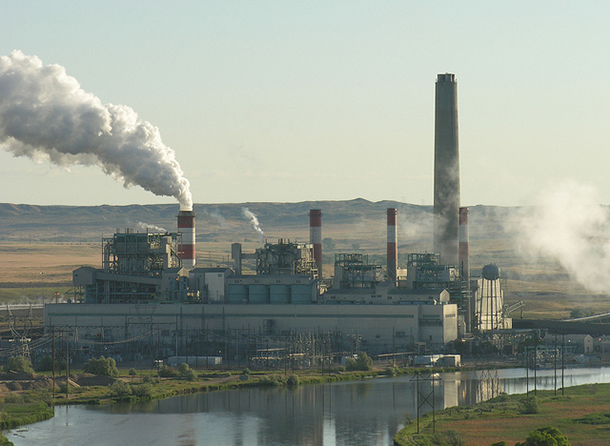
Last week, the UN Green Climate Fund refused to ban the use of green climate change money to build coal plants, claiming the new plants qualify as “clean energy” because they would be cleaner than the older coal plants they’re replacing. (Photo: Greg Goebel, Flickr CC BY-SA 2.0)
CURWOOD: It's Living on Earth. I'm Steve Curwood. Let’s check out what’s beyond the headlines with our usual guide, Peter Dykstra. He’s with Environmental Health News, EHN.org and the DailyClimate.org, and he’s been mining the journalistic world for the unusual, quirky and historical.
He joins us on the line now from Conyers, Georgia. Hi there, Peter.
DYKSTRA: Well, hi, Steve. Let’s start with a mind-boggling decision from the United Nations “Green Climate Fund”. You know, that’s the global fund for rich countries to help developing countries come up with solutions to climate change. Well, last week, the fund refused to ban the use of green climate change money to build coal plants.
CURWOOD: Wait, so you’re saying U.N. money to fix climate change can be used to build additional carbon intensive coal-burning power plants?
DYKSTRA: Yes, and it apparently already has been. Japan loaned over a billion and a half dollars to build new coal plants in Indonesia, Bangladesh, and India. They say it qualifies as “clean energy” because the new coal plants would be cleaner than the older coal plants they’re replacing.
CURWOOD: But I’m still scratching my head, because I don’t think there’s anyone out there saying that new coal-burning power plants are going to help solve climate change.
DYKSTRA: No, and for a UN process that’s already widely viewed with skepticism on all sides, with the crucial climate meeting coming up in Paris at the end of the year, this isn’t encouraging. You know what using climate funds to build coal plants is like? Somebody asked me about plastic water bottles once, and I gave them the lecture about how disposable bottles are an issue, and the plastic is an issue, and the whole speech, so they said, “You’ve convinced me. From now on, no more plastic water bottles.” Now, they buy plastic soda bottles instead.
CURWOOD: Oh man, now I’m depressed. Let’s move on to something more upbeat.
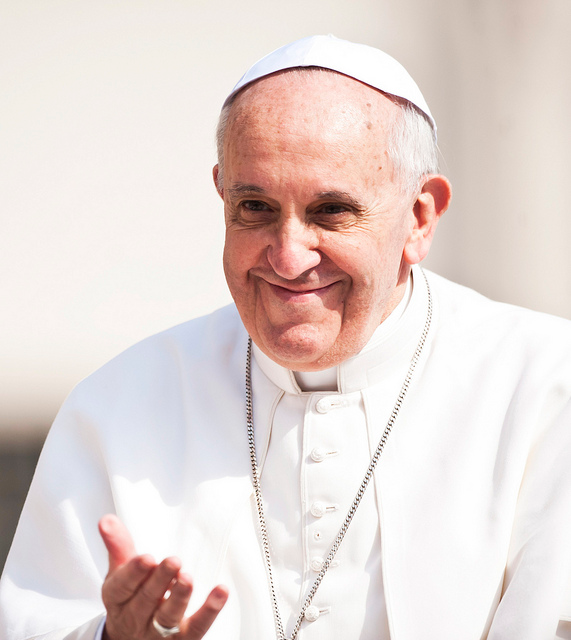
Pope Francis, who has voiced his support for addressing climate change, will be in attendance at the Paris climate negotiations later this year. Other religious leaders have voiced their concerns about climate change as well: seventeen bishops from the Church of England recently issued a “Call to Urgent Action for Climate Justice,” and the presiding bishop of the Episcopal Church in the U.S. declared climate denial “immoral.” (Photo: Catholic Church England and Wales, Flickr CC BY-NC-SA 2.0)
DYKSTRA: One of the things I’ve always observed about the environmental movement is that unlike other political movements, it’s never really had a galvanizing, charismatic leader like Martin Luther King, Nelson Mandela or Gandhi. No disrespect to a lot of people who have done extraordinary work, but I don’t think we’ll ever close the banks and schools to celebrate Al Gore’s birthday or Bill McKibben’s birthday.
CURWOOD: OK, but where are we going with this?
DYKSTRA: So out of the blue, over the last two years, we may be seeing that global leader emerge, complete with a pre-installed following of a billion people: The Pope.
CURWOOD: Yeah, Pope Francis has been very outspoken, and he’ll be at that Paris climate summit, by the way.
DYKSTRA: He will indeed, and a moment please for the time-honored journalistic practice of full disclosure: I am a retired Catholic. Haven’t made it to mass for 40 years or so, but I still watch with interest when the head of the Roman Catholic Church shows true leadership on a vital social issue. And not only that, but if it’s good enough for his holiness, here come the Anglicans. In advance of Holy Week, 17 leading bishops from the Church of England issued a “Call to Urgent Action for Climate Justice", and in a separate statement, the presiding bishop of the Episcopal Church in the US said that climate denial is immoral. While many Catholics and Anglicans – there are about 80 million Anglicans worldwide – have always pushed for social justice, including environmental causes, it’s unusual to see it coming from the top, so stay tuned.
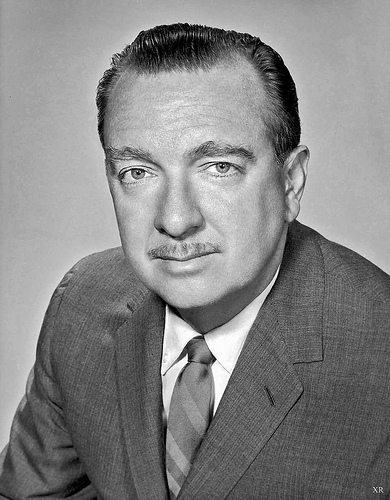
Thirty-five years ago this week, legendary anchorman Walter Cronkite delivered an early warning on climate change. (Photo: James Vaughan, CC BY-NC-SA 2.0)
CURWOOD: Alright. Thank you, Peter, for this week's Easter sermon. Let’s go on to our history lesson.
DYKSTRA: Thirty-five years ago this week, Walter Cronkite, hailed as the “Most Trusted Man in America” delivered a very early warning on climate change. The legendary CBS News anchorman introduced a piece on a 1980 Senate hearing in which Senators and scientists warned of the potential peril of global warming; cities underwater, and hot blazing summers. The veteran CBS reporter Nelson Benton offered these words: “Scientists, and a few politicians, are beginning to worry...”
CURWOOD: And since then, the science has gotten even stronger.
DYKSTRA: But the coverage has gotten weaker. TV news organizations, to say nothing of some politicians, are largely AWOL on climate change, even as its consequences become increasingly real.
CURWOOD: And to quote Walter Cronkite’s nightly sign-off, “That’s the way it is.”
DYKSTRA: Unfortunately true.
CURWOOD: Peter Dykstra is with Environmental Health News, that's EHN.org, and the DailyClimate.org. Thanks, Peter, talk to you soon.
DYKSTRA: Anytime, Steve, we'll talk to you next week.
CURWOOD: And there’s more on these stories at our website LOE.org.
Related links:
- “UN green climate fund can be spent on coal-fired power generation”
- “Christian Duty: Cardinal indicates themes of pope’s climate change document”
- “Anglican bishops lead Holy week call for global climate action”
- “Is climate change denial immoral? US Episcopal Church says yes.”
[MUSIC: CBS News Theme]
Liter of Light

Illac Diaz is the founder of MyShelter Foundation, which seeks to provide affordable and sustainable building solutions for low-income communities. (Photo: courtesy of Liter of Light USA)
CURWOOD: Every so often, we come across an ingenious innovation that we feel we must report on – and we’ve just heard about one called Liter of Light. Now, it’s not exactly our discovery – indeed, this neat invention won the 2015 Zayed Future Energy Prize – an award given by the United Arab Emirates - and its inventor came by to show Living on Earth’s Helen Palmer what it is and how it works.
DIAZ: My name is Illac Diaz, and I’m the Executive Director of Liter of Light Global Movement to open source technologies for solar. Basically we wanted to create the cheapest solar light in the world.
PALMER: And Diaz may just have done that. This light had to be cheap, widely available and local people had to be able to assemble it. The key is empty plastic water bottles.
DIAZ: And one of the things that's most available anywhere in the world was a discarded plastic bottle.
PALMER: So these water bottles that we see ubiquitously everywhere? That's what we’re talking about?
PALMER: I’m talking exactly that, and if you think about it there’s not really any recycling in developing countries, so that bottle is going to last for 100 years, and so we were thinking what if we could make the biggest problem the biggest solution?
PALMER: Illac Diaz is a specialist in disaster rehabilitation – helping developing countries recover from floods and storms, and he had plenty of opportunity in his home country, the Philippines – which suffered the devastation of Typhoon Haiyan in 2013.

An installed Liter of Light kit glows in an otherwise dark home. (Photo: courtesy of Liter of Light USA)
DIAZ: Since 2013 is when the storms are becoming so powerful that instead of slowing down before hitting the archipelago, they actually go straight through, so Haiyan was really an indicator of things to come, where climate change is on us in a very strong way and we’re in front lines.
PALMER: That typhoon flattened over 14 million houses. Aid arrived within 72 hours and included bottles of water that piled up empty behind refugee centers. So Diaz set the many refugees to filling up those plastic bottles with mud, drying them in the sun to use for bricks to build schools. But those mud filled bottles made the schools dark.
DIAZ: One of the big problems with that was really you could not get any flat glass so we’d fill bottles with water and so for bricks fill it with mud, stuck it on top of each other, then in between every one meter fill one with water and this would allow a really beautiful light to envelop the whole school.
PALMER: So those were the first water bottles to bring light inside buildings, but Diaz saw he could use the same technique to light the inside of shacks in cities like Manila where houses are so jam packed together, it’s dark inside. It’s another simple idea – a bottle poking up through the roof to let in the sunlight that could create a business.
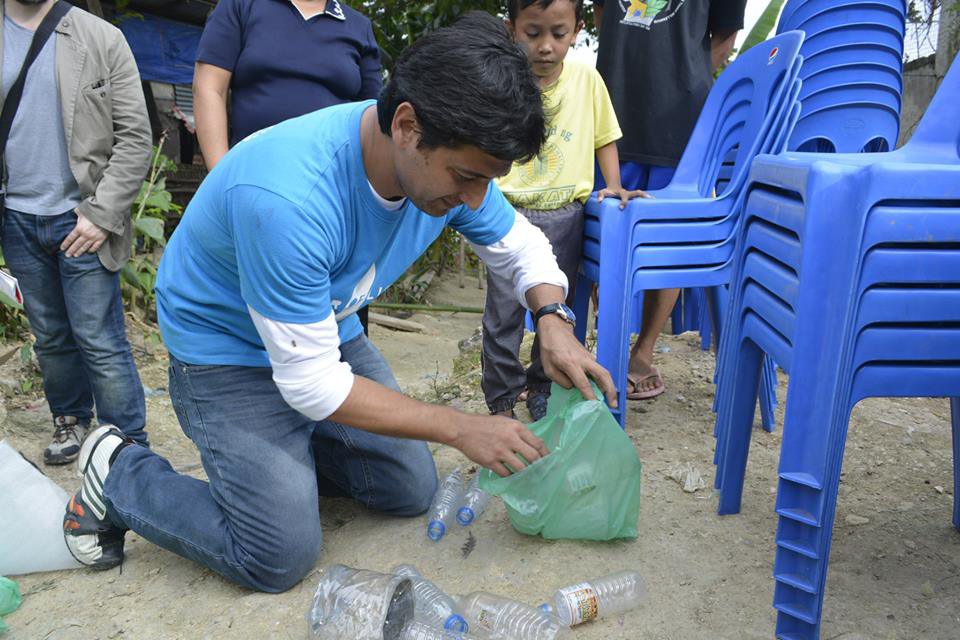
Founder Illac Diaz collects plastic bottles that will later be installed in roofs in energy-poor countries and regions hit by weather disasters. (Photo: courtesy of Liter of Light USA)
DIAZ: And we would have somebody who would collect bottles. He would buy a little piece of tin and glue and stick it. When he installs it, he starts saving that family or that household $8 to $10 worth of electricity a month. And so women would be able to do household chores, cook, clean the house, without having to bring around a candle, and this of course would be one of the main causes of fires. And so, the next household says, "How come I have to clean in the dark with a little candlelight when my neighbor just sticks a plastic bottle in the roof?"
PALMER: So if I'm looking at it, I’d be looking at this corrugated iron roof, and I'd see a third of the bottle sticking up, getting the sunlight, and this is just a bottle – there's no wires, no electricity, no battery?
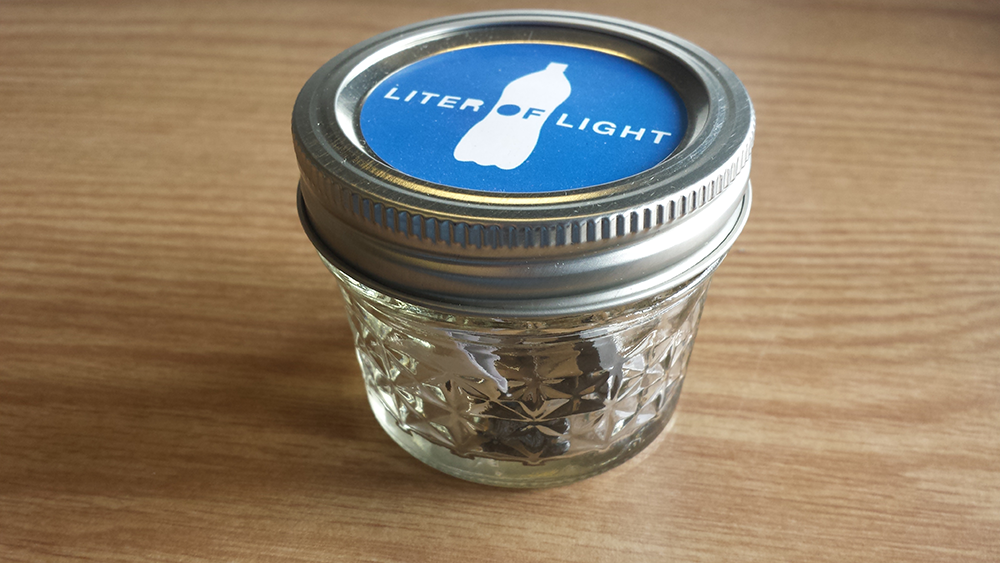
Liter of Light’s kit can generate light energy, is compact and costs about $1.50 US. (Photo: Lauren Hinkel)
DIAZ: No, so we would have a metal sheet like a 12 by 12 metal sheet and we would have a bottle in the middle, and we would have people that we would teach how to do it properly, and what kind of glue to make – of course, all of it local – and in a year we would train about 50 of them. Now, imagine this: each one of them would install about 11,000 lights in about two years.
PALMER: Each of these bottles costs just a dollar fifty to install. Liter of Light made a video of a slum area in the Philippines, Sitio Maligaya, in Central Luzon province where 643 water bottle lights have been stuck in the roofs — and an installer called Solar Demi explains what he does.
[SOUND OF FILM AUDIO, MAN TALKING IN TAGALOG LANGUAGE]
MAN: I’ve brightened up their dark homes. You punch a hole in a piece of metal roofing, apply some sealant, then fill it with filtered water, add some bleach and install it on the roof. Make sure it’s sealed, so the roof won’t leak. It’s that simple.
PALMER: This simple invention has transformed the lives of these slum dwellers, but Diaz says that’s not the half of it. Next came the nighttime solution. It makes use of latest technology – the LED – just a tenth of the power of a standard light bulb – and can also be stuck inside a plastic bottle.
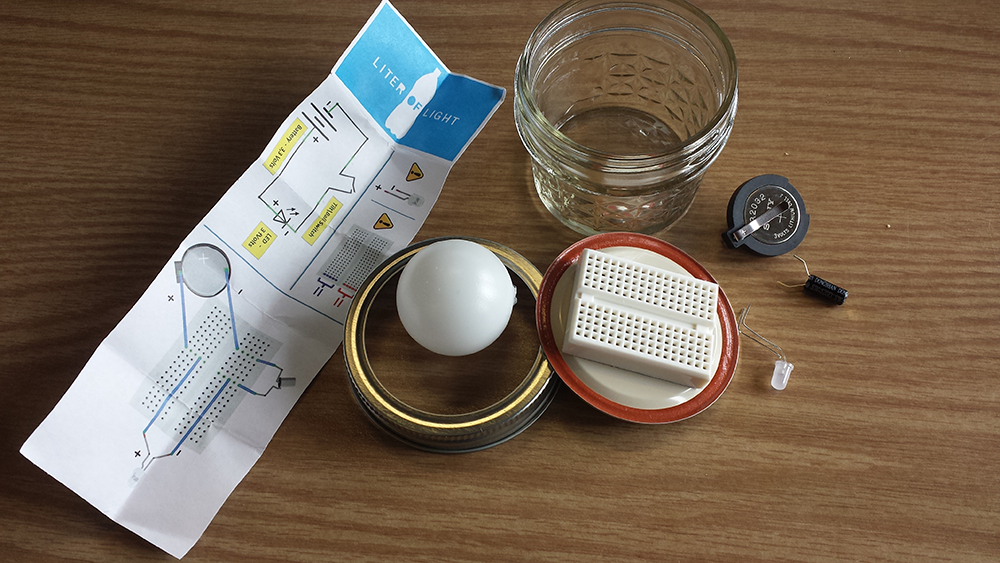
One Liter of Light kit includes a small ping pong ball, an LED light, a battery and a solar panel. (Photo: Lauren Hinkel)
DIAZ: You would open the top, then stick in an LED light inside. So you’d see a bottle with a small one watt solar panel – and with an LED sticking inside – and a switch so even with at one watt at night it would be bright enough for ambient light.
PALMER: Not bright enough to read by, but bright enough so you don’t trip over family members in the house at night. Women were excited by the new lights, and Diaz trained them to assemble the simple circuits that make them work. But many of the women also run small stores and there was a problem with street crime. So they thought brighter lights might make a difference. And the next idea was streetlights, powered by a four watt solar panel, or a motorcycle battery.
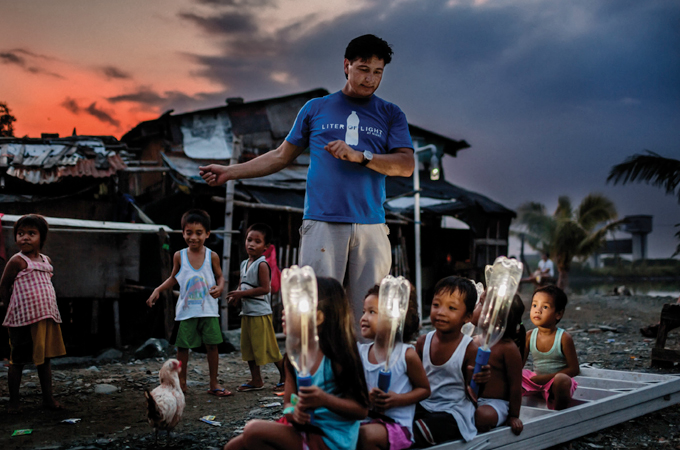
Diaz and children hold constructed light kits. (Photo: courtesy of Liter of Light USA)
DIAZ: And so what we did was we started same thing, but instead of just putting it in circuits for house, we would use the same on and off switch to put in PVC pipes, and then we would have this soldering machine by the sun where we would have a battery and women would be able to solder street lights. And so, PVCs are all over the place, quick to find, you can put them on a bamboo pole, and the plastic bottle, we would put the LEDs inside, and we would attach them not along the streets but along small stores of women. Each woman would have a store, and we would put the lights right in front, you know if it breaks in three years, she would have a little bit of money from us to repair. So that became our business model.
PALMER: Now, you've brought one of them along with you. So, can we have a look at it?
DIAZ: I can bring it over.
PALMER: OK. So to describe it. There's the plastic bottle on the end of one piece of PVC pipe, which is at right angles to a vertical piece and on top of the vertical piece is the solar panels.
DIAZ: And then of course the circuit of turning on and off, there's a box and a battery, this on and off switch. So this one is built by the women. It's just an on and off switch so that you don’t have to turn the light on and off every evening, and then you would have a battery. Sometimes if we're really desperate we use a motorcycle battery, which would probably last for a couple of years. And so we would use PVC. And now, these kinds of small solar panels are very much used in my country and in other countries. So all of this is simply something we can get our hands on immediately. And there you have your four watts of streetlight, so this is four watts. And if you look at the end, all of this is soldered together by hand on a simple aluminum strip, and there you have your streetlight.

Illac Diaz shows former Senator and Secretary of State John Kerry how a plastic bottle can be recycled to provide light. (Photo: courtesy of Liter of Light USA)
PALMER: Each of these streetlights costs $50 to $70 dollars to build, and where they’ve been installed, the crime rate has been cut by 70 percent. Just this year, Diaz says, they’ve installed over 6,000 of these lights worldwide – in Pakistan, in Colombia, in Kenya, in Bangladesh. Liter of Light USA has just launched, appropriately enough at the Thomas Edison museum, and Diaz says they’re teaching children in New Jersey to make the circuits to send to developing countries. That way children in the US they can learn about energy poverty - and have a useful skill for the next time a Hurricane Sandy puts all of us in the dark.
DIAZ: The next generation is to start moving really in a technology of the people, preparing children, preparing people to know how to build these kinds of things, the do-it-yourself streetlights. That’s what Liter of Light is, to go into schools where children and parents find it relevant for the children to be able to know how to build their own streetlights and house lights. We've had experiences for those that we've taught, when they do travel they take our kits with them and then they see somebody who lives in darkness. And it’s something that the children they can build it and donate it – and so they become our missionaries, they become our ambassadors of light. And so this is the way we feel the revolution of solving energy poverty is not by asking people to buy our products, but it's only by multiplying ourselves, by sharing the technology, by getting more people involved that we will be able to solve this.
PALMER: That’s Illac Diaz of Liter of Light. And, Steve, he gave me one of the LED kits the school kids are building here.
CURWOOD: Looks like a tiny mason jar. Let me open it up.
[JAR LID UNSCREWS]
PALMER: Yes, and inside there’s a little circuit board, an LED light, a ping pong ball that becomes the bulb...
[SOUND OF BOUNCING PING PONG BALL]
PALMER: ...and instructions for how to build your very own little light.
CURWOOD: That’s so cool, Helen. Living on Earth's Helen Palmer. And if you want to build your own plastic bottle light there are instructions and much more at our website, LOE.org.
Related links:
- Liter of Light website
- PBS Newshour Profile: Illac Diaz Brings Clean, Cheap Light into Filipino Homes
- How to build a solar bottle bulb
- Liter of Light’s YouTube Channel
[MUSIC: Rockabye Baby, There’s a Light that Never Goes Out, Rockabye Baby Lullaby Renditions of the Smiths, Rockabye Baby Music 2012]
CURWOOD: Living on Earth is produced by the World Media Foundation. Our crew includes Naomi Arenberg, Emmett Fitzgerald, Lauren Hinkel, Helen Palmer, Adelaide Chen, Jenni Doering, John Duff, James Curwood, and Jennifer Marquis. And we’re thrilled this week to welcome Bobby Bascomb’s new daughter, Sage Ellen Bascomb Fabian, all eight and a half pounds of her. Congratulations to her parents, Bobby and Mark! Our show was engineered by Tom Tiger, with help from Jake Rego and Noel Flatt. Alison Lirish Dean composed our themes. You can find us anytime at LOE.org - and like us, please, on our Facebook page - it’s PRI’s Living on Earth. And we tweet from @LivingOnEarth. I'm Steve Curwood. Thanks for listening.
ANNOUNCER1: Funding for Living On Earth comes from the Grantham Foundation for the protection of the environment, supporting strategic communication and collaboration in solving the world’s most pressing environmental problems. The Kendeda Fund, furthering the values that contribute to a healthy planet, and Gilman Ordway for coverage of conservation and environmental change. Living on Earth is also supported by Stonyfield Farm, makers of organic yogurt, smoothies and more. www.stonyfield.com.
ANNOUNCER2: PRI. Public Radio International.
Living on Earth wants to hear from you!
Living on Earth
62 Calef Highway, Suite 212
Lee, NH 03861
Telephone: 617-287-4121
E-mail: comments@loe.org
Newsletter [Click here]
Donate to Living on Earth!
Living on Earth is an independent media program and relies entirely on contributions from listeners and institutions supporting public service. Please donate now to preserve an independent environmental voice.
NewsletterLiving on Earth offers a weekly delivery of the show's rundown to your mailbox. Sign up for our newsletter today!
 Sailors For The Sea: Be the change you want to sea.
Sailors For The Sea: Be the change you want to sea.
 The Grantham Foundation for the Protection of the Environment: Committed to protecting and improving the health of the global environment.
The Grantham Foundation for the Protection of the Environment: Committed to protecting and improving the health of the global environment.
 Contribute to Living on Earth and receive, as our gift to you, an archival print of one of Mark Seth Lender's extraordinary wildlife photographs. Follow the link to see Mark's current collection of photographs.
Contribute to Living on Earth and receive, as our gift to you, an archival print of one of Mark Seth Lender's extraordinary wildlife photographs. Follow the link to see Mark's current collection of photographs.
 Buy a signed copy of Mark Seth Lender's book Smeagull the Seagull & support Living on Earth
Buy a signed copy of Mark Seth Lender's book Smeagull the Seagull & support Living on Earth

